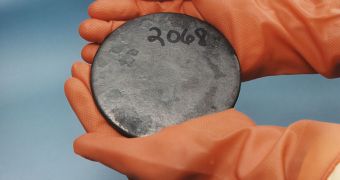The new molecule designed at the University of Virginia is the first uranium methylidyne ever reported, containing an uranium-carbon triple-bond. A methylidyne or methine as it is also known is a tri-valent functional group CH, derived from methane. The methine group consists of a carbon atom with two single bounds and a double bound, where one of the single bounds is to a hydrogen atom.
This experiment opens new ways to understand the complex uranium chemistry. The uranium atom is linked by a triple bound to carbon atoms inside a hydrocarbon. Lester Andrews, the scientist who claims the discovery, is a professor of chemistry at the University of Virginia and has been experimenting with different uranium molecules for over 15 years. To create the novel uranium molecule, he used a focused pulsed laser to evaporate a sample of depleted uranium in a vacuum chamber, reacted the vapor with fluoroform molecules, and he captured the new molecules in frozen argon at 8 K.
The reaction between the uranium vapor and the fluoroform created a C-F bond with the uranium atom, which rearranged the other fluorines and made a new molecule with hydrogen-carbon uranium trifluoride, called uranium trifluoride methylidyne. This kind of triple bond between uranium and carbon is somehow exotic, taking into consideration the well-known radioactivity of the uranium atom.
After the research team created the new molecule, the important process of positively identifying that they have obtained what they were looking for was created. The calculations predicting the structure and the bonding properties of the molecules were compared with the infrared spectroscopy of the new molecule and the results were positive.
Uranium can be found in nature in ores, in the form of three isotopes: uranium-238, uranium 235 and uranium-234. It is radioactive, emitting radiation in the form of alpha particles and is one of the three known fissile elements besides thorium and plutonium, meaning they can easily decay through alpha emission into lighter chemical elements.
The uranium-238 represents 99 percent of the uranium present on Earth and the most stable of the three isotopes with a half-time of about 4.47 billion years, and is unlikely to split if bombarded with a fast neutron, while the uranium-235 which has a half-time of 704 million years, can easily decay when hit with a slow neutron and in the right conditions could trigger a chain reaction similar to that used in the nuclear reactions and release a phenomenal amount of energy, currently used as fuel and to create weapons.
However uranium-235 is found in nature, in less than one percent of the total quantity of uranium. The process of extracting uranium-238 from ore is extremely complicated and involves refining it into metal and enriching the material in the hot isotope before it can be of any use, thus further advances in the uranium chemistry are imperative.

 14 DAY TRIAL //
14 DAY TRIAL //